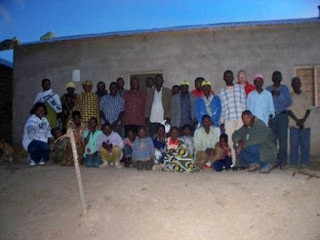Monday: Mwanzo Ilolo








Monday afternoon, Mpeli, Neema, Bonnie, and I visited the village of Ilolo about 40 minutes southwest of Mbeya off the highway to Zambia . Mpeli and Neema had visited the village about a month earlier at the request of a businessman who had connections to the area regarding orphan acre.
Ilolo is a newly formed village of about 550 people. The village sits on top of a series of mountain ridges and is about 4 kilometers long. The village had previously been under the authority of a larger village some distance away. In the last year, they organized themselves to try and find ways to meet critical needs for their community. We met with the chairman of the village, a government representative, the local chief, the village council, and others (not sure who they were other than interested in our being there.). The businessman served as our host and we discovered that he had a farm at the edge of the village. Their presentation of the village history, needs, and specific commitments to transform their village was amazing and unparalleled in sharing their vision.
They had four main concerns. 1. They have no school in the village. We clocked the distance from the village to the school and it was 13.5 kilometers or about 8.5 miles. The children of the village (more than 50) walk to school each day 8.5 miles in the morning and 8.5 miles in the afternoon. As Bonnie said, “I won’t do it. How can they learn anything.” These primary age children leave before dawn and return home after dark at night. The village is making bricks to build a school but were seeking help with someone to teach and resources (similar to the Kidetete primary school started in 2005).
2. They do not have any type of health clinic. Honestly, we are not sure how far the closest one is. Our guess is about 25 minutes by car. They have been making bricks to build a clinic but are seeking help in establishing at least some type of health center for the community—even a part time nurse.
3. The great need is a viable water source. Currently, there are two springs located at the base of the mountains. The springs are approximately at each end of the village. The women walk at least 4 kilometers (2.5 miles) down the mountain to the springs. That is if you live closest. From our observation, the distance is considerably more for most of the village. The hard part is the 2.5 miles back up the mountain carrying water. They are asking for help in establishing a well or some type of way to get water closer to the village (a well is the best idea). The village does not have an evangelical church. This is where the business man was concerned. He knew of Mpeli and Neema’s work with DBL Children Home and the work in Kidetete in planting a church, the well, and orphan care. The businessman said, "Mpeli said to us,'this woman carrying those branches has already gone to get water today. Imagine her day is finished after she gets water and sticks.'" The picture below the woman carrying the sticks actually shows a woman and a child carrying water from one of the springs to her house on top of the ridge. You barely can detect a red spot next to the green grove halfway up the mountain.
4. The fourth concern are the 35 orphans who live in the village.
Please pray for the village and these concerns. We made no commitment only that we would pray specifically about assisting them in development of the village and the planting of a church. In every way this resembles the beginning of our work with Mpeli and Neema over five years ago. Unlike Mpeli and Neema’s situation in Kidetete six years ago, the village is very serious about addressing the issues and transformation of lives. The chairman said, “Just knowing that you (Mpeli and Neema) would bring Mzungus (white people) from America to hear our story and see our village is a great encouragement to us. We pray for the help but if not we know that someone else cares and knows our story.”


0 Comments:
Post a Comment
<< Home